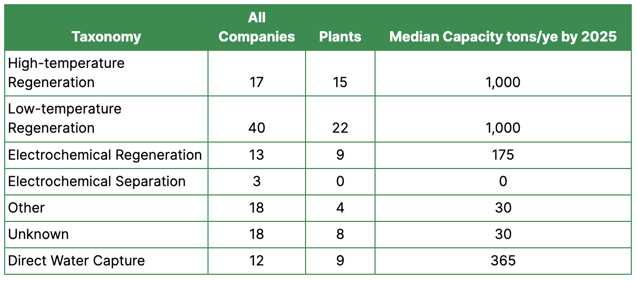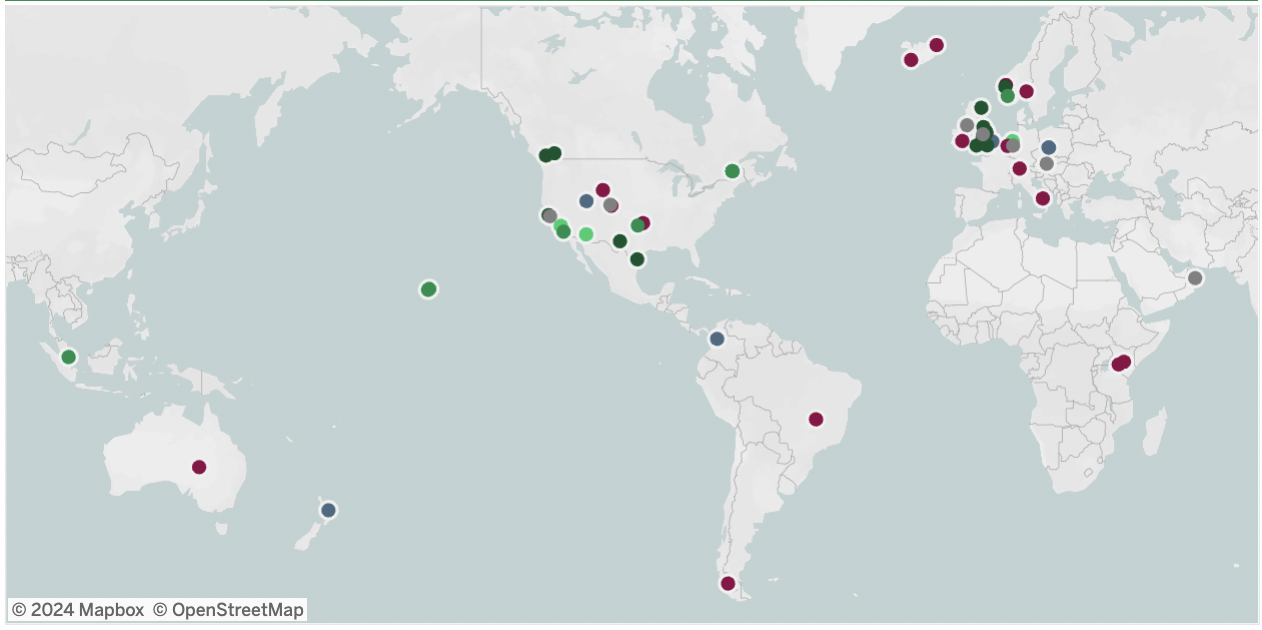Direct air capture (DAC) firms are among the hottest startups in climate tech, having raised nearly $1b since 2020 – and that excludes the billions in grants awarded by the Biden administration in 2023.
While they are en vogue, there is still a poor understanding among carbon market participants around how DAC companies capture carbon. In order to help clarify this, AlliedOffsets underwent desk research to:
- Provide a taxonomy of the different types of DAC, and
- Understand how many DAC firms are already (or have plans to soon be) capturing carbon from the atmosphere.
Taxonomy of DAC
AlliedOffsets has classified each DAC company in our database based on the taxonomy developed by Counteract. The taxonomy we have used is based on the regeneration method of that DAC technology as it can be seen as a way to dissect the industry. The methods covered are:
- Low Temperature Regeneration: uses materials like amines or structures such as zeolites and metal organic frameworks. These substances attract CO2 and release it at 80-120ºC, often with a vacuum, making use of sources like geothermal or waste heat. Companies like Climeworks, Carbon Capture Inc, and Noya are notable players in this field.
- High Temperature Regeneration: uses strong alkali to capture CO2, releasing it at temperatures up to 900ºC, needing high-grade heat sources like natural gas. While aiding rapid scaling, this reliance on fossil fuels may perpetuate emissions. Alternatives like electric furnaces, nuclear energy, or hydrogen have challenges. Carbon Engineering and Heirloom are top DAC companies using high-temperature regeneration.
- Electrochemical Regeneration: uses electrochemistry instead of temperature changes to attract and release CO2. Operating on electricity at ambient conditions, they utilise an electrochemical cell to capture CO2 with alkaline agents and release it using acids. They typically require less energy and can run on renewables. Systems like Mission Zero and Carbon Atlantis can store energy, enabling continuous operation even when green energy is unavailable.
- Electrochemical Separation: uses electrochemistry to both absorb and release CO2. Air is passed through electrochemical cell stacks where membranes or redox active molecules are used to separate CO2. This way the process is entirely powered by electricity and does not require heat. Repair and Verdox are examples of DAC employing electrochemical separation.
- Direct Water Capture (DWC): these companies capture CO2 from the ocean, rather than the air. DWC encompasses a whole family of approaches, too many to cover comprehensively here (well categorised by NOAA). DWC faces different challenges to DAC, such as the requirement to pump and handle significant quantities of saltwater, potentially hazardous byproducts, and challenges with measuring CO2 capture in an open system.
- Other: There are other DAC approaches that do not exactly fit in these groups. For example, some DAC technologies are leveraging pre-existing sources or alkalinity or acid to either capture or regenerate the CO2. These approaches are often linear compared to the typical looping DAC system.
Table 1 shows the numbers of different types of DAC plants, companies and the median capacity of all plants announced to be operational by 2025. The table shows that there are many low-temperature regeneration DAC companies that are working on creating plants, which have not yet announced their plant locations or are in their infancy.

DAC Facilities
Further to the above, we have created a map of all the DAC plants as of the start of 2024, identifying 67 DAC facilities announced worldwide by 37 DAC companies. The map, an extension of the work undertaken by Mission Innovation, classifies projects by the regeneration method, location, capacity, and CO2 utilisation type. Their geographic spread can be seen in Figure 1.

Figure 1: A map of all the different DAC plants by location coloured with their respective DAC technology. Burgundy: Low Temperature Regeneration; Dark Green: High Temperature Regeneration; Black: Electrochemical Separation; Gray: Electrochemical Regeneration; Green: Direct Water Capture; Teal: Other. As a disclaimer when categorising these different DAC plants it was inferred from their website, Open Air Collective series, and Frontier applications.
More on this data in the coming weeks. In the meantime, AlliedOffsets clients can log into their dashboard to view the DAC facilities map here.
